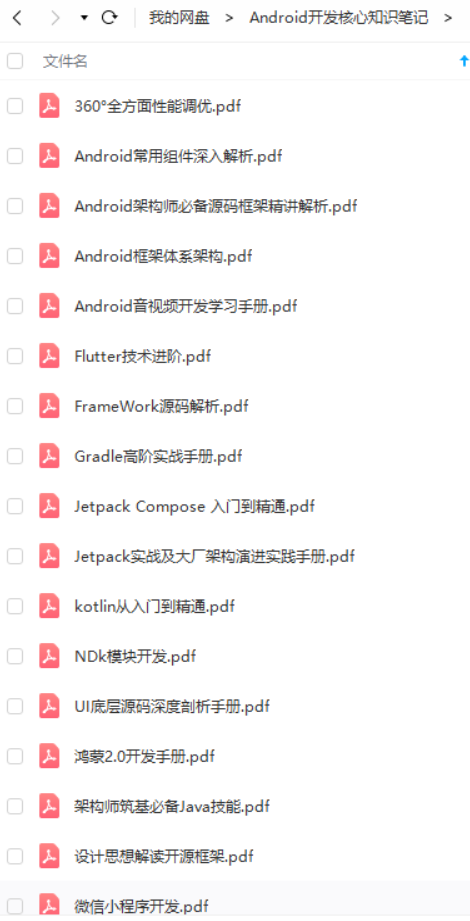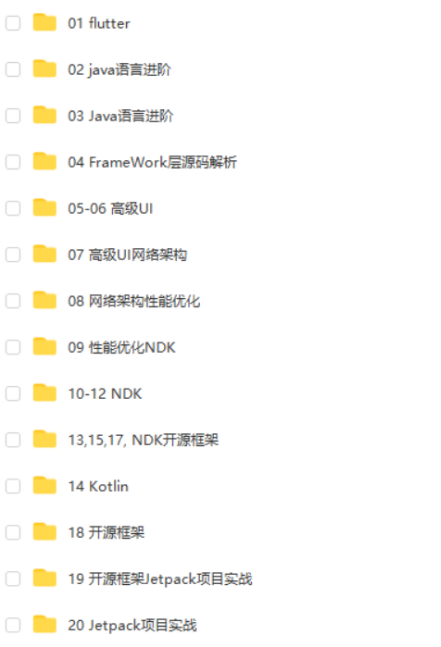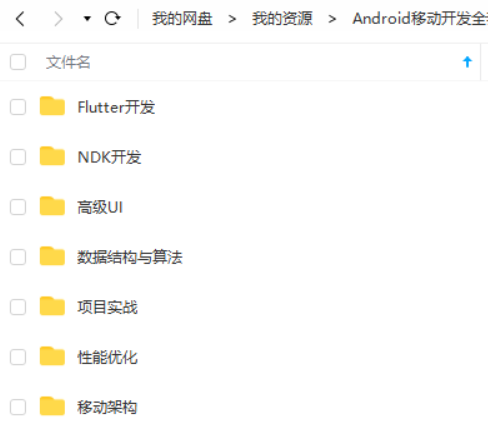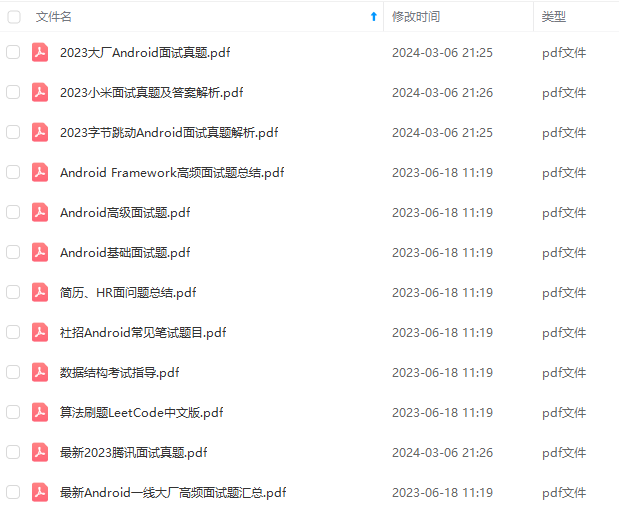@Override
public void onClick(View view) {
int id = view.getId();
switch (id) {
case R.id.video_decode_btn:
mProgressDialog.setMessage(“正在解码…”);
mProgressDialog.show();
mExecutorService.submit(new Runnable() {
@Override
public void run() {
AVUtils.videoDecode(input_video_file_path, output_video_file_path);
}
});
break;
case R.id.video_render_btn:
mExecutorService.submit(new Runnable() {
@Override
public void run() {
AVUtils.videoRender(input_video_file_path, mySurfaceView.getHolder().getSurface());
}
});
break;
case R.id.audio_decode_btn:
mProgressDialog.setMessage(“正在解码…”);
mProgressDialog.show();
mExecutorService.submit(new Runnable() {
@Override
public void run() {
AVUtils.audioDecode(input_audio_file_path, output_audio_file_path);
}
});
break;
case R.id.audio_play_btn:
mExecutorService.submit(new Runnable() {
@Override
public void run() {
AVUtils.audioPlay(input_video_file_path);
}
});
break;
}
}
@Override
public void onFinish() {
runOnUiThread(new Runnable() {
@Override
public void run() {
if (mProgressDialog.isShowing()) {
mProgressDialog.dismiss();
}
Toast.makeText(MainActivity.this, “解码完成”, Toast.LENGTH_SHORT).show();
}
});
}
@Override
protected void onDestroy() {
super.onDestroy();
mExecutorService.shutdown();
}
}
nativelib.c
#include <jni.h>
#include <string.h>
#include <android/log.h>
#include <stdio.h>
#include <libavutil/time.h>
//编码
#include “include/libavcodec/avcodec.h”
//封装格式处理
#include “include/libavformat/avformat.h”
//像素处理
#include “include/libswscale/swscale.h”
#define LOGI(FORMAT, …) __android_log_print(ANDROID_LOG_INFO,“haohao”,FORMAT,##VA_ARGS);
#define LOGE(FORMAT, …) __android_log_print(ANDROID_LOG_ERROR,“haohao”,FORMAT,##VA_ARGS);
//中文字符串转换
jstring charsToUTF8String(JNIEnv *env, char *s) {
jclass string_cls = (*env)->FindClass(env, “java/lang/String”);
jmethodID mid = (*env)->GetMethodID(env, string_cls, “”, “([BLjava/lang/String;)V”);
jbyteArray jb_arr = (*env)->NewByteArray(env, strlen(s));
(*env)->SetByteArrayRegion(env, jb_arr, 0, strlen(s), s);
jstring charset = (*env)->NewStringUTF(env, “UTF-8”);
return (*env)->NewObject(env, string_cls, mid, jb_arr, charset);
}
JNIEXPORT void JNICALL
Java_com_haohao_ffmpeg_AVUtils_videoDecode(JNIEnv *env, jclass type, jstring input_,
jstring output_) {
//访问静态方法
jmethodID mid = (*env)->GetStaticMethodID(env, type, “onNativeCallback”, “()V”);
//需要转码的视频文件(输入的视频文件)
const char *input = (*env)->GetStringUTFChars(env, input_, 0);
const char *output = (*env)->GetStringUTFChars(env, output_, 0);
//注册所有组件
av_register_all();
//封装格式上下文,统领全局的结构体,保存了视频文件封装格式的相关信息
AVFormatContext *pFormatCtx = avformat_alloc_context();
//打开输入视频文件
if (avformat_open_input(&pFormatCtx, input, NULL, NULL) != 0) {
LOGE(“%s”, “无法打开输入视频文件”);
return;
}
//获取视频文件信息,例如得到视频的宽高
if (avformat_find_stream_info(pFormatCtx, NULL) < 0) {
LOGE(“%s”, “无法获取视频文件信息”);
return;
}
//获取视频流的索引位置
//遍历所有类型的流(音频流、视频流、字幕流),找到视频流
int v_stream_idx = -1;
int i = 0;
for (; i < pFormatCtx->nb_streams; i++) {
//判断视频流
if (pFormatCtx->streams[i]->codec->codec_type == AVMEDIA_TYPE_VIDEO) {
v_stream_idx = i;
break;
}
}
if (v_stream_idx == -1) {
LOGE(“%s”, “找不到视频流\n”);
return;
}
//根据视频的编码方式,获取对应的解码器
AVCodecContext *pCodecCtx = pFormatCtx->streams[v_stream_idx]->codec;
//根据编解码上下文中的编码 id 查找对应的解码器
AVCodec *pCodec = avcodec_find_decoder(pCodecCtx->codec_id);
if (pCodec == NULL) {
LOGE(“%s”, “找不到解码器,或者视频已加密\n”);
return;
}
//打开解码器,解码器有问题(比如说我们编译FFmpeg的时候没有编译对应类型的解码器)
if (avcodec_open2(pCodecCtx, pCodec, NULL) < 0) {
LOGE(“%s”, “解码器无法打开\n”);
return;
}
//输出视频信息
LOGI(“视频的文件格式:%s”, pFormatCtx->iformat->name);
LOGI(“视频时长:%lld”, (pFormatCtx->duration) / (1000 * 1000));
LOGI(“视频的宽高:%d,%d”, pCodecCtx->width, pCodecCtx->height);
LOGI(“解码器的名称:%s”, pCodec->name);
//准备读取
//AVPacket用于存储一帧一帧的压缩数据(H264)
//缓冲区,开辟空间
AVPacket *packet = (AVPacket *) av_malloc(sizeof(AVPacket));
//AVFrame用于存储解码后的像素数据(YUV)
//内存分配
AVFrame *pFrame = av_frame_alloc();
//YUV420
AVFrame *pFrameYUV = av_frame_alloc();
//只有指定了AVFrame的像素格式、画面大小才能真正分配内存
//缓冲区分配内存
uint8_t *out_buffer = (uint8_t *) av_malloc(
avpicture_get_size(AV_PIX_FMT_YUV420P, pCodecCtx->width, pCodecCtx->height));
//初始化缓冲区
avpicture_fill((AVPicture *) pFrameYUV, out_buffer, AV_PIX_FMT_YUV420P, pCodecCtx->width,
pCodecCtx->height);
//用于转码(缩放)的参数,转之前的宽高,转之后的宽高,格式等
struct SwsContext *sws_ctx = sws_getContext(pCodecCtx->width, pCodecCtx->height,
pCodecCtx->pix_fmt,
pCodecCtx->width, pCodecCtx->height,
AV_PIX_FMT_YUV420P,
SWS_BICUBIC, NULL, NULL, NULL);
int got_picture, ret;
//输出文件
FILE *fp_yuv = fopen(output, “wb+”);
int frame_count = 0;
//一帧一帧的读取压缩数据
while (av_read_frame(pFormatCtx, packet) >= 0) {
//只要视频压缩数据(根据流的索引位置判断)
if (packet->stream_index == v_stream_idx) {
//解码一帧视频压缩数据,得到视频像素数据
ret = avcodec_decode_video2(pCodecCtx, pFrame, &got_picture, packet);
if (ret < 0) {
LOGE(“%s”, “解码错误”);
return;
}
//为 0 说明解码完成,非0正在解码
if (got_picture) {
//AVFrame转为像素格式YUV420,宽高
//2 6输入、输出数据
//3 7输入、输出画面一行的数据的大小 AVFrame 转换是一行一行转换的
//4 输入数据第一列要转码的位置 从0开始
//5 输入画面的高度
sws_scale(sws_ctx, pFrame->data, pFrame->linesize, 0, pCodecCtx->height,
pFrameYUV->data, pFrameYUV->linesize);
//输出到YUV文件
//AVFrame像素帧写入文件
//data解码后的图像像素数据(音频采样数据)
//Y 亮度 UV 色度(压缩了) 人对亮度更加敏感
//U V 个数是Y的1/4
int y_size = pCodecCtx->width * pCodecCtx->height;
fwrite(pFrameYUV->data[0], 1, y_size, fp_yuv);
fwrite(pFrameYUV->data[1], 1, y_size / 4, fp_yuv);
fwrite(pFrameYUV->data[2], 1, y_size / 4, fp_yuv);
frame_count++;
LOGI(“解码第%d帧”, frame_count);
}
}
//释放资源
av_free_packet(packet);
}
fclose(fp_yuv);
av_frame_free(&pFrame);
avcodec_close(pCodecCtx);
avformat_free_context(pFormatCtx);
(*env)->ReleaseStringUTFChars(env, input_, input);
(*env)->ReleaseStringUTFChars(env, output_, output);
//通知 Java 层解码完毕
(*env)->CallStaticVoidMethod(env, type, mid);
}
//使用这两个 Window 相关的头文件需要在 CMake 脚本中引入 android 库
#include <android/native_window_jni.h>
#include <android/native_window.h>
#include “include/yuv/libyuv.h”
JNIEXPORT void JNICALL
Java_com_haohao_ffmpeg_AVUtils_videoRender(JNIEnv *env, jclass type, jstring input_,
jobject surface) {
//需要转码的视频文件(输入的视频文件)
const char *input = (*env)->GetStringUTFChars(env, input_, 0);
//注册所有组件
av_register_all();
//avcodec_register_all();
//封装格式上下文,统领全局的结构体,保存了视频文件封装格式的相关信息
AVFormatContext *pFormatCtx = avformat_alloc_context();
//打开输入视频文件
if (avformat_open_input(&pFormatCtx, input, NULL, NULL) != 0) {
LOGE(“%s”, “无法打开输入视频文件”);
return;
}
//获取视频文件信息,例如得到视频的宽高
//第二个参数是一个字典,表示你需要获取什么信息,比如视频的元数据
if (avformat_find_stream_info(pFormatCtx, NULL) < 0) {
LOGE(“%s”, “无法获取视频文件信息”);
return;
}
//获取视频流的索引位置
//遍历所有类型的流(音频流、视频流、字幕流),找到视频流
int v_stream_idx = -1;
int i = 0;
//number of streams
for (; i < pFormatCtx->nb_streams; i++) {
//流的类型
if (pFormatCtx->streams[i]->codec->codec_type == AVMEDIA_TYPE_VIDEO) {
v_stream_idx = i;
break;
}
}
if (v_stream_idx == -1) {
LOGE(“%s”, “找不到视频流\n”);
return;
}
//获取视频流中的编解码上下文
AVCodecContext *pCodecCtx = pFormatCtx->streams[v_stream_idx]->codec;
//根据编解码上下文中的编码 id 查找对应的解码器
AVCodec *pCodec = avcodec_find_decoder(pCodecCtx->codec_id);
if (pCodec == NULL) {
LOGE(“%s”, “找不到解码器,或者视频已加密\n”);
return;
}
//打开解码器,解码器有问题(比如说我们编译FFmpeg的时候没有编译对应类型的解码器)
if (avcodec_open2(pCodecCtx, pCodec, NULL) < 0) {
LOGE(“%s”, “解码器无法打开\n”);
return;
}
//准备读取
//AVPacket用于存储一帧一帧的压缩数据(H264)
//缓冲区,开辟空间
AVPacket *packet = (AVPacket *) av_malloc(sizeof(AVPacket));
//AVFrame用于存储解码后的像素数据(YUV)
//内存分配
AVFrame *yuv_frame = av_frame_alloc();
AVFrame *rgb_frame = av_frame_alloc();
int got_picture, ret;
int frame_count = 0;
//窗体
ANativeWindow *pWindow = ANativeWindow_fromSurface(env, surface);
//绘制时的缓冲区
ANativeWindow_Buffer out_buffer;
//一帧一帧的读取压缩数据
while (av_read_frame(pFormatCtx, packet) >= 0) {
//只要视频压缩数据(根据流的索引位置判断)
if (packet->stream_index == v_stream_idx) {
//7.解码一帧视频压缩数据,得到视频像素数据
ret = avcodec_decode_video2(pCodecCtx, yuv_frame, &got_picture, packet);
if (ret < 0) {
LOGE(“%s”, “解码错误”);
return;
}
//为0说明解码完成,非0正在解码
if (got_picture) {
//lock window
//设置缓冲区的属性:宽高、像素格式(需要与Java层的格式一致)
ANativeWindow_setBuffersGeometry(pWindow, pCodecCtx->width, pCodecCtx->height,
WINDOW_FORMAT_RGBA_8888);
ANativeWindow_lock(pWindow, &out_buffer, NULL);
//初始化缓冲区
//设置属性,像素格式、宽高
//rgb_frame的缓冲区就是Window的缓冲区,同一个,解锁的时候就会进行绘制
avpicture_fill((AVPicture *) rgb_frame, out_buffer.bits, AV_PIX_FMT_RGBA,
pCodecCtx->width,
pCodecCtx->height);
//YUV格式的数据转换成RGBA 8888格式的数据, FFmpeg 也可以转换,但是存在问题,使用libyuv这个库实现
I420ToARGB(yuv_frame->data[0], yuv_frame->linesize[0],
yuv_frame->data[2], yuv_frame->linesize[2],
yuv_frame->data[1], yuv_frame->linesize[1],
rgb_frame->data[0], rgb_frame->linesize[0],
pCodecCtx->width, pCodecCtx->height);
//3、unlock window
ANativeWindow_unlockAndPost(pWindow);
frame_count++;
LOGI(“解码绘制第%d帧”, frame_count);
}
}
//释放资源
av_free_packet(packet);
}
av_frame_free(&yuv_frame);
avcodec_close(pCodecCtx);
avformat_free_context(pFormatCtx);
(*env)->ReleaseStringUTFChars(env, input_, input);
}
#include “libswresample/swresample.h”
#define MAX_AUDIO_FRME_SIZE 48000 * 4
//音频解码(重采样)
JNIEXPORT void JNICALL
Java_com_haohao_ffmpeg_AVUtils_audioDecode(JNIEnv *env, jclass type, jstring input_,
jstring output_) {
//访问静态方法
jmethodID mid = (*env)->GetStaticMethodID(env, type, “onNativeCallback”, “()V”);
const char *input = (*env)->GetStringUTFChars(env, input_, 0);
const char *output = (*env)->GetStringUTFChars(env, output_, 0);
//注册组件
av_register_all();
AVFormatContext *pFormatCtx = avformat_alloc_context();
//打开音频文件
if (avformat_open_input(&pFormatCtx, input, NULL, NULL) != 0) {
LOGI(“%s”, “无法打开音频文件”);
return;
}
//获取输入文件信息
if (avformat_find_stream_info(pFormatCtx, NULL) < 0) {
LOGI(“%s”, “无法获取输入文件信息”);
return;
}
//获取音频流索引位置
int i = 0, audio_stream_idx = -1;
for (; i < pFormatCtx->nb_streams; i++) {
if (pFormatCtx->streams[i]->codec->codec_type == AVMEDIA_TYPE_AUDIO) {
audio_stream_idx = i;
break;
}
}
//获取解码器
AVCodecContext *codecCtx = pFormatCtx->streams[audio_stream_idx]->codec;
AVCodec *codec = avcodec_find_decoder(codecCtx->codec_id);
if (codec == NULL) {
LOGI(“%s”, “无法获取解码器”);
return;
}
//打开解码器
if (avcodec_open2(codecCtx, codec, NULL) < 0) {
LOGI(“%s”, “无法打开解码器”);
return;
}
//压缩数据
AVPacket *packet = (AVPacket *) av_malloc(sizeof(AVPacket));
//解压缩数据
AVFrame *frame = av_frame_alloc();
//frame->16bit 44100 PCM 统一音频采样格式与采样率
SwrContext *swrCtx = swr_alloc();
//重采样设置参数
//输入的采样格式
enum AVSampleFormat in_sample_fmt = codecCtx->sample_fmt;
//输出采样格式16bit PCM
enum AVSampleFormat out_sample_fmt = AV_SAMPLE_FMT_S16;
//输入采样率
int in_sample_rate = codecCtx->sample_rate;
//输出采样率
int out_sample_rate = 44100;
//获取输入的声道布局
//根据声道个数获取默认的声道布局(2个声道,默认立体声stereo)
//av_get_default_channel_layout(codecCtx->channels);
uint64_t in_ch_layout = codecCtx->channel_layout;
//输出的声道布局(立体声)
uint64_t out_ch_layout = AV_CH_LAYOUT_STEREO;
swr_alloc_set_opts(swrCtx,
out_ch_layout, out_sample_fmt, out_sample_rate,
in_ch_layout, in_sample_fmt, in_sample_rate,
0, NULL);
swr_init(swrCtx);
//输出的声道个数
int out_channel_nb = av_get_channel_layout_nb_channels(out_ch_layout);
//重采样设置参数
//位宽16bit 采样率 44100HZ 的 PCM 数据
uint8_t *out_buffer = (uint8_t *) av_malloc(MAX_AUDIO_FRME_SIZE);
FILE *fp_pcm = fopen(output, “wb”);
int got_frame = 0, index = 0, ret;
//不断读取压缩数据
while (av_read_frame(pFormatCtx, packet) >= 0) {
//解码
ret = avcodec_decode_audio4(codecCtx, frame, &got_frame, packet);
if (ret < 0) {
LOGI(“%s”, “解码完成”);
}
//解码一帧成功
if (got_frame > 0) {
LOGI(“解码:%d”, index++);
swr_convert(swrCtx, &out_buffer, MAX_AUDIO_FRME_SIZE, frame->data, frame->nb_samples);
//获取sample的size
int out_buffer_size = av_samples_get_buffer_size(NULL, out_channel_nb,
frame->nb_samples, out_sample_fmt, 1);
fwrite(out_buffer, 1, out_buffer_size, fp_pcm);
}
av_free_packet(packet);
}
fclose(fp_pcm);
av_frame_free(&frame);
av_free(out_buffer);
swr_free(&swrCtx);
avcodec_close(codecCtx);
avformat_close_input(&pFormatCtx);
(*env)->ReleaseStringUTFChars(env, input_, input);
(*env)->ReleaseStringUTFChars(env, output_, output);
//通知 Java 层解码完成
(*env)->CallStaticVoidMethod(env, type, mid);
}
JNIEXPORT void JNICALL
Java_com_haohao_ffmpeg_AVUtils_audioPlay(JNIEnv *env, jclass type, jstring input_) {
const char *input = (*env)->GetStringUTFChars(env, input_, 0);
LOGI(“%s”, “sound”);
//注册组件
av_register_all();
AVFormatContext *pFormatCtx = avformat_alloc_context();
//打开音频文件
if (avformat_open_input(&pFormatCtx, input, NULL, NULL) != 0) {
LOGI(“%s”, “无法打开音频文件”);
return;
}
//获取输入文件信息
if (avformat_find_stream_info(pFormatCtx, NULL) < 0) {
LOGI(“%s”, “无法获取输入文件信息”);
return;
}
//获取音频流索引位置
int i = 0, audio_stream_idx = -1;
for (; i < pFormatCtx->nb_streams; i++) {
if (pFormatCtx->streams[i]->codec->codec_type == AVMEDIA_TYPE_AUDIO) {
audio_stream_idx = i;
break;
}
}
//获取解码器
AVCodecContext *codecCtx = pFormatCtx->streams[audio_stream_idx]->codec;
AVCodec *codec = avcodec_find_decoder(codecCtx->codec_id);
if (codec == NULL) {
LOGI(“%s”, “无法获取解码器”);
return;
}
//打开解码器
if (avcodec_open2(codecCtx, codec, NULL) < 0) {
LOGI(“%s”, “无法打开解码器”);
return;
}
//压缩数据
AVPacket *packet = (AVPacket *) av_malloc(sizeof(AVPacket));
//解压缩数据
AVFrame *frame = av_frame_alloc();
//frame->16bit 44100 PCM 统一音频采样格式与采样率
SwrContext *swrCtx = swr_alloc();
//输入的采样格式
enum AVSampleFormat in_sample_fmt = codecCtx->sample_fmt;
//输出采样格式16bit PCM
enum AVSampleFormat out_sample_fmt = AV_SAMPLE_FMT_S16;
//输入采样率
int in_sample_rate = codecCtx->sample_rate;
//输出采样率
int out_sample_rate = in_sample_rate;
//获取输入的声道布局
//根据声道个数获取默认的声道布局(2个声道,默认立体声stereo)
//av_get_default_channel_layout(codecCtx->channels);
uint64_t in_ch_layout = codecCtx->channel_layout;
//输出的声道布局(立体声)
uint64_t out_ch_layout = AV_CH_LAYOUT_STEREO;
swr_alloc_set_opts(swrCtx,
out_ch_layout, out_sample_fmt, out_sample_rate,
in_ch_layout, in_sample_fmt, in_sample_rate,
0, NULL);
swr_init(swrCtx);
//输出的声道个数
int out_channel_nb = av_get_channel_layout_nb_channels(out_ch_layout);
//AudioTrack对象
jmethodID create_audio_track_mid = (*env)->GetStaticMethodID(env, type, “createAudioTrack”,
“(II)Landroid/media/AudioTrack;”);
jobject audio_track = (*env)->CallStaticObjectMethod(env, type, create_audio_track_mid,
out_sample_rate, out_channel_nb);
//调用AudioTrack.play方法
jclass audio_track_class = (*env)->GetObjectClass(env, audio_track);
jmethodID audio_track_play_mid = (*env)->GetMethodID(env, audio_track_class, “play”, “()V”);
jmethodID audio_track_stop_mid = (*env)->GetMethodID(env, audio_track_class, “stop”, “()V”);
(*env)->CallVoidMethod(env, audio_track, audio_track_play_mid);
//AudioTrack.write
jmethodID audio_track_write_mid = (*env)->GetMethodID(env, audio_track_class, “write”,
“([BII)I”);
//16bit 44100 PCM 数据
uint8_t *out_buffer = (uint8_t *) av_malloc(MAX_AUDIO_FRME_SIZE);
int got_frame = 0, index = 0, ret;
//不断读取压缩数据
while (av_read_frame(pFormatCtx, packet) >= 0) {
//解码音频类型的Packet
if (packet->stream_index == audio_stream_idx) {
//解码
ret = avcodec_decode_audio4(codecCtx, frame, &got_frame, packet);
if (ret < 0) {
LOGI(“%s”, “解码完成”);
}
//解码一帧成功
if (got_frame > 0) {
LOGI(“解码:%d”, index++);
swr_convert(swrCtx, &out_buffer, MAX_AUDIO_FRME_SIZE,
(const uint8_t **) frame->data, frame->nb_samples);
//获取sample的size
int out_buffer_size = av_samples_get_buffer_size(NULL, out_channel_nb,
frame->nb_samples, out_sample_fmt,
1);
//out_buffer缓冲区数据,转成byte数组
jbyteArray audio_sample_array = (*env)->NewByteArray(env, out_buffer_size);
jbyte *sample_bytep = (*env)->GetByteArrayElements(env, audio_sample_array, NULL);
//out_buffer的数据复制到sampe_bytep
memcpy(sample_bytep, out_buffer, out_buffer_size);
//同步
(*env)->ReleaseByteArrayElements(env, audio_sample_array, sample_bytep, 0);
//AudioTrack.write PCM数据
(*env)->CallIntMethod(env, audio_track, audio_track_write_mid,
audio_sample_array, 0, out_buffer_size);
//释放局部引用
(*env)->DeleteLocalRef(env, audio_sample_array);
}
}
av_free_packet(packet);
}
(*env)->CallVoidMethod(env, audio_track, audio_track_stop_mid);
av_frame_free(&frame);
av_free(out_buffer);
swr_free(&swrCtx);
avcodec_close(codecCtx);
avformat_close_input(&pFormatCtx);
(*env)->ReleaseStringUTFChars(env, input_, input);
}
CMakeLists.txt
cmake_minimum_required(VERSION 3.4.1)
include_directories(
C
M
A
K
E
S
O
U
R
C
E
D
I
R
/
s
r
c
/
m
a
i
n
/
c
p
p
/
i
n
c
l
u
d
e
)
s
e
t
(
j
n
i
l
i
b
s
"
{CMAKE_SOURCE_DIR}/src/main/cpp/include) set(jnilibs "
CMAKESOURCEDIR/src/main/cpp/include)set(jnilibs"{CMAKE_SOURCE_DIR}/src/main/jniLibs")
set(CMAKE_LIBRARY_OUTPUT_DIRECTORY
j
n
i
l
i
b
s
/
{jnilibs}/
jnilibs/{ANDROID_ABI})
add_library( # Sets the name of the library.
native-lib
Sets the library as a shared library.
SHARED
Provides a relative path to your source file(s).
src/main/cpp/native-lib.c)
添加 FFmpeg 的 8 个函数库和 yuvlib 库
add_library(avutil-54 SHARED IMPORTED )
set_target_properties(avutil-54 PROPERTIES IMPORTED_LOCATION “
j
n
i
l
i
b
s
/
{jnilibs}/
jnilibs/{ANDROID_ABI}/libavutil-54.so”)
add_library(swresample-1 SHARED IMPORTED )
set_target_properties(swresample-1 PROPERTIES IMPORTED_LOCATION “
j
n
i
l
i
b
s
/
{jnilibs}/
jnilibs/{ANDROID_ABI}/libswresample-1.so”)
add_library(avcodec-56 SHARED IMPORTED )
set_target_properties(avcodec-56 PROPERTIES IMPORTED_LOCATION “
j
n
i
l
i
b
s
/
{jnilibs}/
jnilibs/{ANDROID_ABI}/libavcodec-56.so”)
add_library(avformat-56 SHARED IMPORTED )
set_target_properties(avformat-56 PROPERTIES IMPORTED_LOCATION “
j
n
i
l
i
b
s
/
{jnilibs}/
jnilibs/{ANDROID_ABI}/libavformat-56.so”)
add_library(swscale-3 SHARED IMPORTED )
set_target_properties(swscale-3 PROPERTIES IMPORTED_LOCATION “
j
n
i
l
i
b
s
/
{jnilibs}/
jnilibs/{ANDROID_ABI}/libswscale-3.so”)
add_library(postproc-53 SHARED IMPORTED )
set_target_properties(postproc-53 PROPERTIES IMPORTED_LOCATION “
j
n
i
l
i
b
s
/
{jnilibs}/
jnilibs/{ANDROID_ABI}/libpostproc-53.so”)
add_library(avfilter-5 SHARED IMPORTED )
set_target_properties(avfilter-5 PROPERTIES IMPORTED_LOCATION “
j
n
i
l
i
b
s
/
{jnilibs}/
jnilibs/{ANDROID_ABI}/libavfilter-5.so”)
add_library(avdevice-56 SHARED IMPORTED )
set_target_properties(avdevice-56 PROPERTIES IMPORTED_LOCATION “
j
n
i
l
i
b
s
/
{jnilibs}/
jnilibs/{ANDROID_ABI}/libavdevice-56.so”)
add_library(yuv SHARED IMPORTED )
set_target_properties(yuv PROPERTIES IMPORTED_LOCATION “
j
n
i
l
i
b
s
/
{jnilibs}/
jnilibs/{ANDROID_ABI}/libyuv.so”)
find_library( # Sets the name of the path variable.
log-lib
Specifies the name of the NDK library that
you want CMake to locate.
log )
#找到 Android 系统 Window 绘制相关的库
find_library(
android-lib
android
)
target_link_libraries( native-lib
${log-lib}
${android-lib}
avutil-54
swresample-1
avcodec-56
avformat-56
swscale-3
postproc-53
avfilter-5
avdevice-56
yuv)
PS:
- 注意添加文件读写权限。
二、音视频同步原理与实现
2.1、原理
如果简单的按照音频的采样率与视频的帧率去播放,由于机器运行速度,解码效率等种种造成时间差异的因素影响,很难同步,音视频时间差将会呈现线性增长。所以要做音视频的同步,有三种方式:
1.参考一个外部时钟,将音频与视频同步至此时间。我首先想到这种方式,但是并不好,由于某些生物学的原理,人对声音的变化比较敏感,但是对视觉变化不太敏感。所以频繁的去调整声音的播放会有些刺耳或者杂音吧影响用户体验。(ps:顺便科普生物学知识,自我感觉好高大上_)。
2.以视频为基准,音频去同步视频的时间。不采用,理由同上。
3.以音频为基准,视频去同步音频的时间。 所以这个办法了。
所以,原理就是以音频时间为基准,判断视频快了还是慢了,从而调整视频速度。其实是一个动态的追赶与等待的过程。
2.2、一些概念
音视频中都有DTS与PTS。
DTS ,Decoding Time Stamp,解码时间戳,告诉解码器packet的解码顺序。
PTS ,Presentation Time Stamp,显示时间戳,指示从packet中解码出来的数据的显示顺序。
音频中二者是相同的,但是视频由于B帧(双向预测)的存在,会造成解码顺序与显示顺序并不相同,也就是视频中DTS与PTS不一定相同。
时间基 :看FFmpeg源码
/**
- This is the fundamental unit of time (in seconds) in terms
- of which frame timestamps are represented. For fixed-fps content,
- timebase should be 1/framerate and timestamp increments should be
- identically 1.
- This often, but not always is the inverse of the frame rate or field rate
- for video.
-
- encoding: MUST be set by user.
-
- decoding: the use of this field for decoding is deprecated.
-
Use framerate instead.
*/
AVRational time_base;
/**
- rational number numerator/denominator
*/
typedef struct AVRational{
int num; ///< numerator
int den; ///< denominator
} AVRational;
个人理解,其实就是ffmpeg中的用分数表示时间单位,num为分子,den为分母。并且ffmpeg提供了计算方法:
/**
- Convert rational to double.
- @param a rational to convert
- @return (double) a
*/
static inline double av_q2d(AVRational a){
return a.num / (double) a.den;
}
所以 视频中某帧的显示时间 计算方式为(单位为妙):
time = pts * av_q2d(time_base);
2.3、同步代码
1、 音频部分
clock 为音频的播放时长(从开始到当前的时间)
if (packet->pts != AV_NOPTS_VALUE) {
自我介绍一下,小编13年上海交大毕业,曾经在小公司待过,也去过华为、OPPO等大厂,18年进入阿里一直到现在。
深知大多数初中级Android工程师,想要提升技能,往往是自己摸索成长或者是报班学习,但对于培训机构动则近万的学费,着实压力不小。自己不成体系的自学效果低效又漫长,而且极易碰到天花板技术停滞不前!
因此收集整理了一份《2024年Android移动开发全套学习资料》,初衷也很简单,就是希望能够帮助到想自学提升又不知道该从何学起的朋友,同时减轻大家的负担。





既有适合小白学习的零基础资料,也有适合3年以上经验的小伙伴深入学习提升的进阶课程,基本涵盖了95%以上Android开发知识点,真正体系化!
由于文件比较大,这里只是将部分目录截图出来,每个节点里面都包含大厂面经、学习笔记、源码讲义、实战项目、讲解视频,并且会持续更新!
如果你觉得这些内容对你有帮助,可以扫码获取!!(备注:Android)

文末
对于很多初中级Android工程师而言,想要提升技能,往往是自己摸索成长,不成体系的学习效果低效漫长且无助。 整理的这些架构技术希望对Android开发的朋友们有所参考以及少走弯路,本文的重点是你有没有收获与成长,其余的都不重要,希望读者们能谨记这一点。
最后想要拿高薪实现技术提升薪水得到质的飞跃。最快捷的方式,就是有人可以带着你一起分析,这样学习起来最为高效,所以为了大家能够顺利进阶中高级、架构师,我特地为大家准备了一套高手学习的源码和框架视频等精品Android架构师教程,保证你学了以后保证薪资上升一个台阶。
当你有了学习线路,学习哪些内容,也知道以后的路怎么走了,理论看多了总要实践的。
进阶学习视频

附上:我们之前因为秋招收集的二十套一二线互联网公司Android面试真题 (含BAT、小米、华为、美团、滴滴)和我自己整理Android复习笔记(包含Android基础知识点、Android扩展知识点、Android源码解析、设计模式汇总、Gradle知识点、常见算法题汇总。)

《互联网大厂面试真题解析、进阶开发核心学习笔记、全套讲解视频、实战项目源码讲义》点击传送门即可获取!
记、源码讲义、实战项目、讲解视频,并且会持续更新!**
如果你觉得这些内容对你有帮助,可以扫码获取!!(备注:Android)

文末
对于很多初中级Android工程师而言,想要提升技能,往往是自己摸索成长,不成体系的学习效果低效漫长且无助。 整理的这些架构技术希望对Android开发的朋友们有所参考以及少走弯路,本文的重点是你有没有收获与成长,其余的都不重要,希望读者们能谨记这一点。
最后想要拿高薪实现技术提升薪水得到质的飞跃。最快捷的方式,就是有人可以带着你一起分析,这样学习起来最为高效,所以为了大家能够顺利进阶中高级、架构师,我特地为大家准备了一套高手学习的源码和框架视频等精品Android架构师教程,保证你学了以后保证薪资上升一个台阶。
当你有了学习线路,学习哪些内容,也知道以后的路怎么走了,理论看多了总要实践的。
进阶学习视频
[外链图片转存中…(img-gN9lgyvj-1712614482307)]
附上:我们之前因为秋招收集的二十套一二线互联网公司Android面试真题 (含BAT、小米、华为、美团、滴滴)和我自己整理Android复习笔记(包含Android基础知识点、Android扩展知识点、Android源码解析、设计模式汇总、Gradle知识点、常见算法题汇总。)
[外链图片转存中…(img-92ygS5tx-1712614482307)]
《互联网大厂面试真题解析、进阶开发核心学习笔记、全套讲解视频、实战项目源码讲义》点击传送门即可获取!






















 1196
1196











 被折叠的 条评论
为什么被折叠?
被折叠的 条评论
为什么被折叠?








